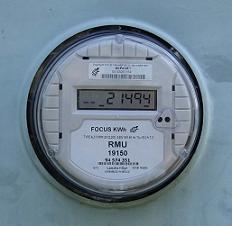 Electricity used in your home is measured in kilowatt-hours. As a quick reference, a 100 watt light bulb burning for 10 hours uses one kilowatt-hour. Being able to read your electric meter will provide a good way to monitor electric consumption in your home. The following illustration has been provided as a guide on how to read your electric meter.
Electricity used in your home is measured in kilowatt-hours. As a quick reference, a 100 watt light bulb burning for 10 hours uses one kilowatt-hour. Being able to read your electric meter will provide a good way to monitor electric consumption in your home. The following illustration has been provided as a guide on how to read your electric meter.
Most RMU meters are digital and can be read by simply looking at the numbers on the face. Similar to an odometer in a car recording mileage, a digital meter records the amount of kilowatt-hours as they are used.
Keep in mind that when RMU meter readers take readings on your meter, they DO NOT set it back to zero. Therefore the numbers keep turning until the next time the meter is read. By subtracting two consecutive readings, the amount of electric usage is determined for the month. When the readings are entered they are immediately checked to see if the reading is about the same as the one the previous month. If it is quite a bit lower or higher, the meter reader is asked to re-read the meter to make sure the reading is correct. This helps to ensure your bill is accurate each and every month.
So, now what?
Once you know how to read your meter, it’s easy to figure out how much electricity you have used since your last electric bill. Simply look at last month’s electric bill to find the reading recorded by RMU meter readers. Then, subtract last month’s reading from the number you just took off your meter. What you end up with is the total number of kilowatt-hours you have used since your last reading. You can also use the handy tool we have available on our website: Residential Bill Calculator
Remember, just reading the meter alone will not save money; however, it will help you become more aware of overall energy consumption, and being aware is the first step to making wise decisions.
Where does all that electricity go?
As much as 50% of electricity consumption in your home is from your heating and air conditioning equipment. Older, less insulated homes use even more electricity. Water heaters are usually the second largest user of electricity in your home. After that come major appliances like refrigerators, stoves, washers, and dryers, followed by smaller items like TV’s, lamps and stereos.
There are things you can do to save energy, and save money in the long run. To see some energy conservation ideas click here.
